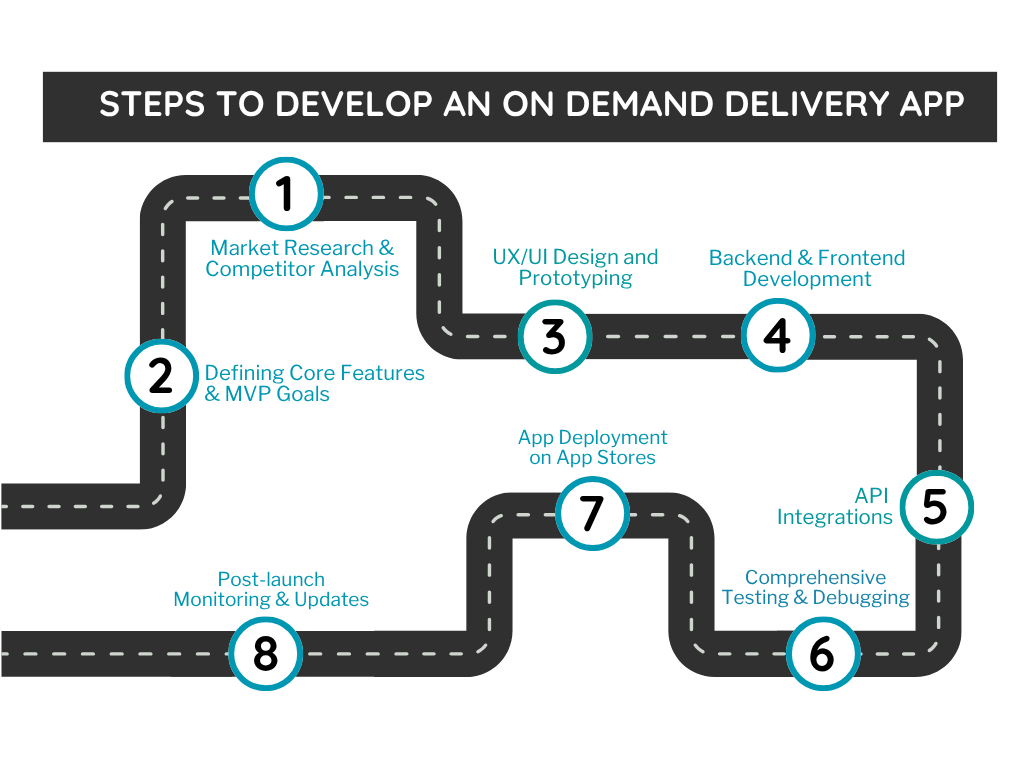The modern digital landscape thrives on speed and convenience. Today’s consumers expect products and services to arrive swiftly, sometimes in minutes. This shift has propelled the rise of on demand delivery platforms across sectors such as food, grocery, healthcare, and logistics.
In this comprehensive 2025 guide, we’ll walk you through everything you need to know about building a high-performance on demand delivery app, including viable business models, industry-specific use cases, critical features, step-by-step development stages, cost analysis, and essential performance metrics.
What Is an On Demand Delivery App?
An on demand delivery app is a digital solution that enables users to order products or services and receive them in real time or on a scheduled basis. These platforms streamline the entire experience, from placing an order and making payments to live tracking and final delivery, all within a unified ecosystem.
Popular Business Models for On Demand Delivery Apps
Selecting the right operational model plays a crucial role in your app’s scalability and profitability. Here are the most commonly adopted business models:
The right business model is foundational to your app’s scalability and profitability. Here are the top models driving success:
1. Aggregator Platform:
Connects users with multiple independent service providers (e.g., Uber Eats).
2. End-to-End Provider:
Owns the entire value chain from inventory to delivery (e.g., Domino’s).
3. Hybrid Marketplace + Logistics:
Combines transaction facilitation with logistics (e.g., Amazon Prime Now).
4. White-Label Solution:
Offers customizable platforms that brands can deploy under their identity with minimal effort.
Top Sectors Using On Demand Delivery Apps for Growth
While food delivery remains dominant, numerous industries now adopt the on demand model for growth:
1. Food & Grocery:
Streamlining essentials via DoorDash, Swiggy, and Instacart.
2. Healthcare & Pharmacy:
Fast medicine delivery through NetMeds and 1mg.
3. Courier & Logistics:
Real-time parcel services with Postmates and Dunzo.
4. Home Services:
Apps like UrbanClap enable on-demand cleaning, repairs, and laundry.
5. Retail & eCommerce:
Flipkart Quick and Shopify provide same-day deliveries.
Essential Features for an On Demand Delivery Application
Creating a successful on demand delivery app involves integrating features that streamline interactions between customers, delivery agents, and administrators. These core functionalities enhance user satisfaction, optimize workflow, and support the platform’s long-term scalability.
1. Customer Panel
As the primary user interface, the customer panel must be intuitive, responsive, and feature-rich:
1.1. Easy Registration & Login:
Provide seamless access through phone numbers, emails, or social logins.
1.2. Product/Service Listings:
Categorized displays with advanced filters and search capabilities.
1.3. Live Order Tracking:
Enable users to view real-time location updates and estimated delivery times.
1.4. Multiple Payment Options:
Integrate secure gateways such as PayPal, Stripe, credit/debit cards, and UPI.
1.5. Ratings & Feedback:
Allow users to share their experiences to build trust and transparency.
1.6. Push Notifications:
Keep users updated on order status, delivery progress, and promotional offers.
2. Delivery Agent Panel
This module is designed to help delivery personnel efficiently manage and complete tasks:
2.1. Instant Order Alerts:
Notify agents of new delivery requests in real-time.
2.2. Smart Navigation:
GPS-based route optimization ensures timely and accurate deliveries.
2.3. Task Management:
Accept or reject orders, update delivery statuses, and manage assigned tasks.
2.4. Earnings Tracker:
View completed deliveries and daily/weekly earnings summaries.
2.5. In-App Chat:
Direct communication with customers or support for better service coordination.
3. Admin Dashboard
The admin panel serves as the operational hub, offering control and insights across the entire platform:
3.1. User & Vendor Management:
Monitor and manage user accounts, delivery staff, and merchant profiles.
3.2. Order Tracking & Analytics:
View order volumes, average delivery times, and other key performance metrics.
3.3. Marketing Tools:
Launch and manage promotional campaigns, coupons, and referral programs.
3.4. Inventory Oversight:
Track product availability and supplier relationships (ideal for retail or grocery models).
3.5. Support & Query Handling:
Address customer issues, assign tickets, and oversee resolution workflows.
By implementing these vital features, your on demand delivery app can deliver a seamless user experience, improve service efficiency, and stay competitive in an increasingly fast-paced digital economy.
Process of On Demand Delivery App Development
Creating a robust on demand platform requires methodical planning and execution. Here’s a breakdown of the essential development phases:

Step 1: Conduct Market Research & Analyze Competitors
Identify your audience’s pain points, observe competitors, and understand user expectations. This stage informs both your business model and feature set.
Step 2: Define Core Features & Minimum Viable Product (MVP)
List the foundational features for early release order placement, GPS tracking, payments, etc. An MVP approach ensures faster time-to-market and validates your concept with real users.
Step 3: Design User-Centric UX/UI and Build Prototypes
Designers create wireframes and clickable prototypes to map intuitive user journeys. A responsive, accessible, and visually cohesive interface is critical for user retention.
Step 4: Develop Frontend and Backend Systems
The engineering team builds both the customer-facing frontend and the back-end development infrastructure. The latter powers real-time data syncing, authentication, and storage management.
Step 5: Integrate Key APIs
Speed up development by integrating proven third-party APIs:
- Location Services: Google Maps or Mapbox.
- Payment Gateways: Stripe, Razorpay, or PayPal.
- Messaging APIs: Twilio and Firebase for SMS, calls, and notifications.
Step 6: Comprehensive Testing & QA
Testing covers functional, performance, UI/UX, and cross-device compatibility. Simulated real-world usage ensures a bug-free and reliable experience.
Step 7: App Store Deployment
Launch on iOS and Android platforms following their guidelines. Use compelling visuals, descriptions, and keywords to boost app visibility.
Step 8: Post-Launch Monitoring & Updates
Monitor user behavior and technical performance post-launch. Regular updates help fix bugs, roll out new features, and align with the latest app development trends.
Estimated Cost of Building an On Demand Delivery App In 2025
App development cost varies based on functionality, development location, and technology stack. Here’s a general breakdown:
Component | Estimated Cost (USD) |
UI/UX Design | $5,000 – $10,000 |
App Development | $20,000 – $50,000 |
API Integration | $3,000 – $8,000 |
Quality Assurance (QA) | $3,000 – $7,000 |
Deployment & Marketing | $2,000 – $5,000 |
Total Cost Estimate: $30,000 to $80,000 for a feature-rich MVP.
To optimize cost:
- Launch with a feature-focused MVP.
- Use cross-platform tech like Flutter.
- Leverage third-party APIs.
- Hire mobile developers from offshore teams to save time and money.
How On Demand Delivery Works?
Cutting costs without sacrificing quality is key. Here are smart strategies:
- Launch with an MVP to validate your idea.
- Use cross-platform frameworks like Flutter or React Native.
- Integrate third-party APIs for essential features like maps, payments, and chat.
- Collaborate with an offshore development team to reduce costs without compromising quality.
This process forms the backbone of any scalable on demand courier delivery app.
Key Metrics to Measure App Success
Evaluating the performance of your on demand delivery app is essential for ensuring its growth, user satisfaction, and long-term viability.
By focusing on specific Key Performance Indicators (KPIs), you can make informed decisions that drive improvements across the platform. Below are the core metrics that every successful on-demand app should monitor:
1. Customer Acquisition Cost (CAC)
This metric indicates the total cost involved in acquiring a new customer. It includes all expenses related to marketing, sales, and onboarding efforts.
CAC = Total Marketing + Sales Costs ÷ Number of New Customers
A lower CAC combined with high user growth reflects effective outreach and cost efficiency.
2. Customer Retention Rate & Repeat Usage
Retaining existing users is significantly more cost-effective than attracting new ones. This metric shows how frequently customers return to place orders, helping you understand app loyalty and satisfaction.
High retention often correlates with a strong user experience and reliable service.
3. Delivery Time Accuracy
Timely delivery is a key performance factor in user satisfaction. This metric tracks how fast and accurately orders are fulfilled. Shorter delivery windows can enhance customer trust and give your platform a competitive edge.
4. Revenue Per User (RPU)
RPU measures how much income is generated per active user over a certain period.
RPU = Total Revenue ÷ Number of Active Users
It helps you evaluate monetization efficiency and understand how much each customer contributes to your bottom line.
5. Net Promoter Score (NPS)
NPS is a customer loyalty index that measures how likely users are to recommend your app to others. It provides qualitative insight into overall satisfaction and can highlight potential areas for improvement.
Scoring Categories:
- Promoters (9–10): Enthusiastic advocates likely to refer others
- Passives (7–8): Satisfied but not highly engaged
- Detractors (0–6): Unhappy users who may negatively impact your brand
6. App Churn or Uninstall Rate
This metric reflects how many users stop using your app or uninstall it over time. A high churn rate could indicate usability issues, performance problems, or a lack of engagement. Minimizing churn is essential for steady user base growth.
Why These Metrics Matter
By regularly monitoring these key performance indicators, you gain actionable insights that can drive product updates, enhance customer engagement, and boost operational efficiency.
These metrics help ensure your on demand delivery app evolves with user needs and remains competitive in a rapidly changing marketplace.
Final Thoughts
As real-time service expectations continue to rise, building an on demand delivery platform has become a strategic imperative. Partnering with the right on-demand app development company, one that offers Hybrid App Development Services and has experience in MVPs, API integration, and scaling, can significantly impact your success.
Whether you’re an enterprise or a startup, choosing a trusted On Demand App Development Company or mobile app development company will help bring your idea to market with precision and agility.

Partner with Experts
Frequently Asked Questions
What are the key features of a successful on demand delivery app?






Core features include:
- Real-time order tracking
- Multiple payment options
- In-app chat and notifications
- Rating and review systems
- Admin dashboard with analytics
- Route optimization for delivery agents
What Tech Stack Is Best for an On Demand Courier Delivery App?










Selecting the right tech stack is crucial for building a scalable and high-performance courier app. Here’s a widely used configuration:
- Frontend: React Native or Flutter
- Backend: Node.js, Python, or Laravel
- Database: MongoDB or PostgreSQL
- Push Notifications: Firebase Cloud Messaging
How do on demand delivery apps make money?










These apps typically earn revenue through commissions, delivery charges, advertising, and premium subscriptions for vendors or users.
What business model should I choose for my delivery app?










It depends on your target market and operational capacity. Common models include:
- Aggregator (multiple providers)
- Full-service (end-to-end logistics)
- Marketplace with logistics
- White-label platform for resellers




